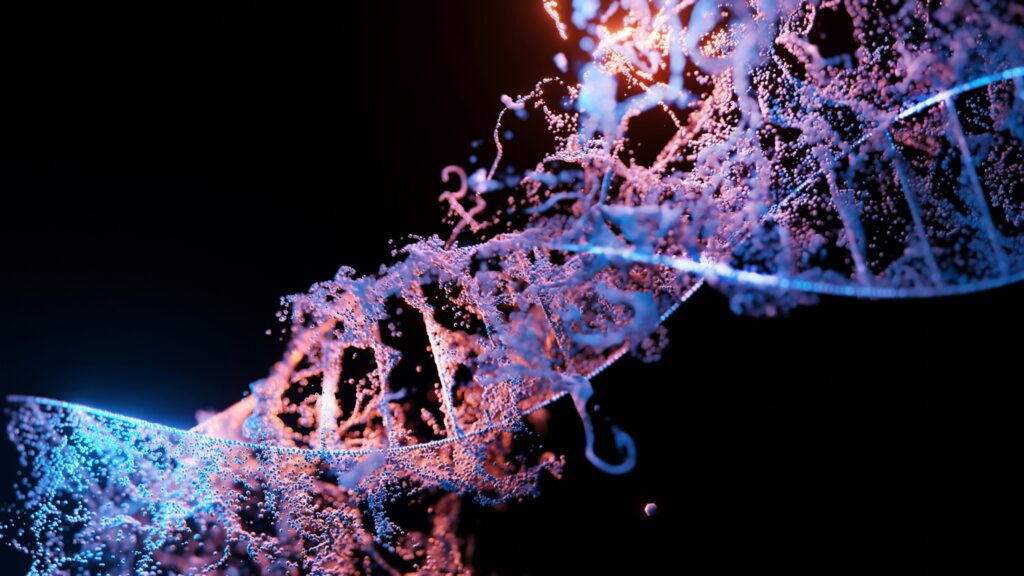Thariq Abdulkalam, India

From the embryonic thought that triggers a man’s neurological response to the readiness of a woman’s organs, reproduction follows a series of precise and well-organised steps. This article explores how the Holy Quran, in a single verse, explains this complex process with remarkable accuracy – while also tackling the allegations raised against this verse.
One of the common criticisms raised against the Holy Quran involves its alleged scientific inaccuracies. One of them is targeted at its description of human creation, particularly towards the process of human reproduction. In the Holy Quran, Allah says:
“He is created from a gushing fluid, Which issues forth from between the loins and the breast-bones.” (Surah al-Tariq, Ch. 86: V. 7-8)
While modern science has shown that semen, the fluid in charge of human reproduction, is not produced between the loins and breastbone, how come a scripture that is widely claimed to be divine makes such an enormous blunder?
This article focuses on addressing this allegation by examining the terminologies used by the Holy Quran and providing details from the human anatomical findings. Before delving deep, it is also essential to understand the level of knowledge about reproduction during the time at which this holy scripture was revealed.
The idea of castration
Castration has been performed in both humans and animals for a long time, with practices dating back years to ancient Egypt and Arabia. (S N Buyukunal and Ayten Altintaş, A Short History of ‘Oriental Testis’, pp. 129-140)
In these nations, slaves were often castrated and traded in markets. The process involved the forceful rupture or removal of the testes. Such strong evidence suggests that, since ancient times, the origin of sperm was understood to be from the testes. Therefore, it is highly improbable that the Holy Quran, revealed to the Holy Foundersa of Islam, would contradict this well-established knowledge. Moreover, in the sayings of the Holy Prophetsa, incidents are recorded that prove his knowledge of the castration practices. One such narration, reported by Hazrat Sa’d ibn Abi Waqqasra, recounts that:
“Allah’s Messengersa forbade `Uthman bin Maz’un to abstain from marrying (and other pleasures) and if he had allowed him, we would have gotten ourselves castrated.” (Sahih al-Bukhari, Hadith 5073)
The above references prove that the apparent contradiction in the Quran is not due to a lack of understanding; rather, a deeper and broader interpretation of the said verse is requisite to wholly appreciate its intended meaning.
Some literal interpretations of this verse describe the origin of human creation to be from a gushing fluid that emerges between the loins of a man and the breastbones of a woman. But ‘Abdullah ibn ‘Abbasra, an ardent companion of the Holy Prophetsa, provided an explanation, stating:
“Proceeding from between the sulb and the tara‘ib: from the backbone of the man and the ribs of the woman.” (Ibn Kathir, Tafsir Ibn Kathir, Vol. 10, commentary on Surah 86:7, Dar-us-Salam)
In his Tafsir-e-Kabir, the Quranic commentary, Hazrat Mirza Bashiruddin Mahmud Ahmadra, the second Caliph of the Ahmadiyya Muslim Community explains that ‘sulb’ refers to ‘sulbul abi’ (the loins of the father) and ‘tara‘ib’ to ‘taraibul ummi’ (the breastbone of the mother). (Tafsir-e-Kabir [2023], Vol. 12, p. 10)
The loins
The male loin plays a significant role in the production of semen within the male reproductive system. Though the term ‘loin’ is often used in literature to denote the genitals, it is also important to understand its scientific relevance.
The term ‘loins’ is often used to define the lower abdominal region of the human body, along with the area surrounding the hips. This is where the ‘semen-producing’ reproductive organs are located, including the vas deferens, prostate, and seminal vesicles. While sperm is produced in the testes, the organs within the loins help in supplying the necessary fluids and nutrients. They nourish the sperm and enable their transport while also aiding the forceful expulsion during ejaculation.
The loin region also includes the lower back and sides of the body, which enclose the lumbar vertebrae and the surrounding muscles and tissues.
The role of Lumbar Vertebrae in ejaculation
The human vertebral column is divided into five different categories. The third segment from the top is known as the lumbar vertebrae. It consists of five individual vertebrae, namely L1 to L5, characterised by their strength and size. They play a definite role in bearing the body weight and preserving its stability.
The lumbar vertebrae, in the loins, play a crucial part in the production of seminal fluid. In the case of rats, the Spinal Generator of Ejaculation (SGE) – a neural centre located in the spinal cord that is responsible for regulating ejaculation – is positioned between the L3 and L5. Though this neural centre has not been directly identified in human beings, studies have shown that in patients with spinal cord injuries, especially the ones with significant damage to the lumbar vertebrae, external stimuli aimed at inducing ejaculation (such as PVS) were ineffective. It was observed that the injury to the L3 – L5 segments was the sole reason behind this failure. These findings shed light on the monumental role played by the loin, or the lumbar region, in the process of ejaculation. (Clément Chéhensse, Stéphane Bahrami, Pierre Denys, Pierre Clément, Jacques Bernabé, François Giuliano, The spinal control of ejaculation revisited: a systematic review and meta-analysis of anejaculation in spinal cord injured patients, Human Reproduction Update, Vol. 19, Issue 5, September/October 2013, pp. 507-526; Chéhensse, C.; Facchinetti, P.; Bahrami, S.; Andrey, P.; Soler, J.; Chrétien, F.; Bernabé, J.; Clément, P.; Denys, P.; Giuliano, F. Human spinal ejaculation generator. Ann. Neurol. 2016, Issue 81, pp. 35-45)
The meaning of tara‘ib
The Arabic word ‘tara‘ib’ is the plural of ‘tareeba’. While it is generally translated as ‘ribs’ or ‘breastbones’, the meaning extends beyond that. The ribs are mostly referred to using the word “ḍilʻ” (singular) or “ḍuloo‘” (plural). Tara‘ib is rarely used and appears only once in the Holy Quran.
‘Tareeba’ encompasses several meanings, including certain parts of the breast, specific bones, or even limbs and eyes. Thus, ‘tara‘ib’ is used here in a broader sense, referring to multiple organs of the human body. Lane’s Lexicon also records that “…most of the authors on strange words affirm decidedly that it (the usage of the word ‘tara‘ib’) is peculiar to women.” (Lane’s Lexicon, Vol. 1, p. 301)
When taken together, the above two points lead us to the conclusion that, in this context, ‘tara‘ib’ refers to multiple organs found exclusively in women, a description that perfectly aligns with the female reproductive system – the uterus, fallopian tubes, and ovaries.
The anatomy of female reproduction
On the 14th day of the female menstrual cycle, tiny structures called follicles start to grow within the ovaries, triggered by the release of female hormones. These follicles contain an immature egg surrounded by a fluid. One of these follicles matures, nourishing the enclosed egg, and prepares it to be released from the ovary by a process called ovulation. Around the 14th day, the egg and the fluid are released into the abdominal cavity, which is then guided towards the fallopian tube, where fertilisation with the sperm occurs.
Eventually, the fertilised egg, or the embryo, moves into the uterus and attaches to the uterine wall, where it develops and advances into a human foetus.
Conclusion
During sexual intercourse, a neural signal from the man’s loins (sulb) initiates the process of semen production. The seminal fluid, carrying sperm, is eventually released into the female reproductive tract. In the female body (tara‘ib), a sperm meets an awaiting egg, initiating fertilisation. Pregnancy – impossible without the man’s initiation and the woman’s readiness – when seen alongside the neural signal from the man’s sulb and the preparedness of the woman’s tara‘ib, shows how the Holy Quran, in a single verse, captures the grandeur of reproduction with unparalleled precision.

